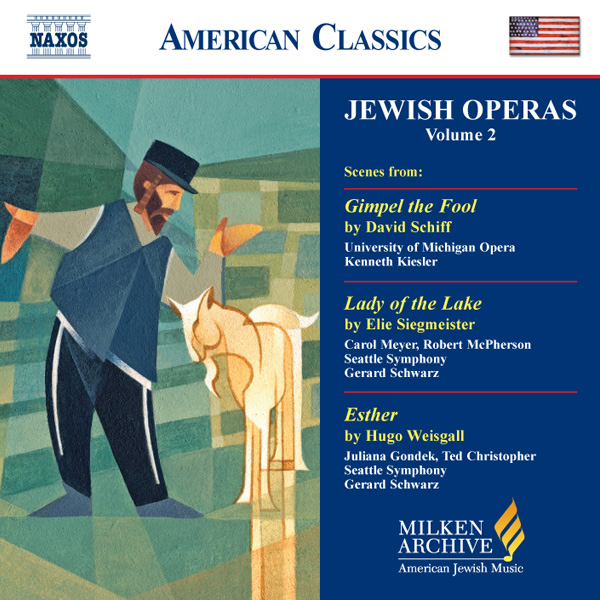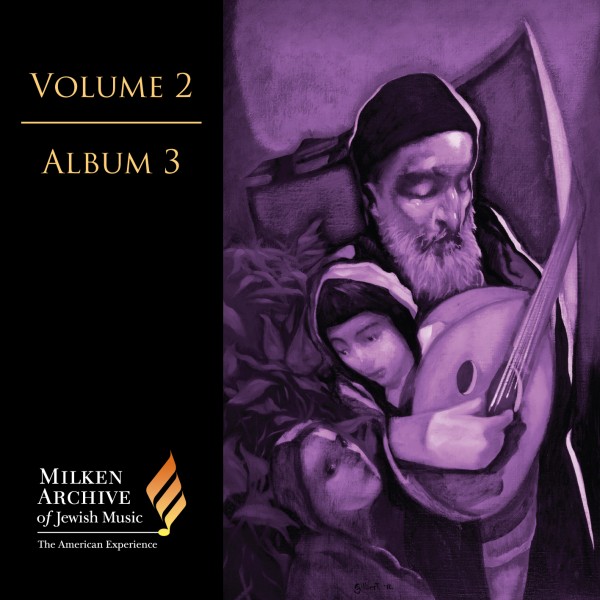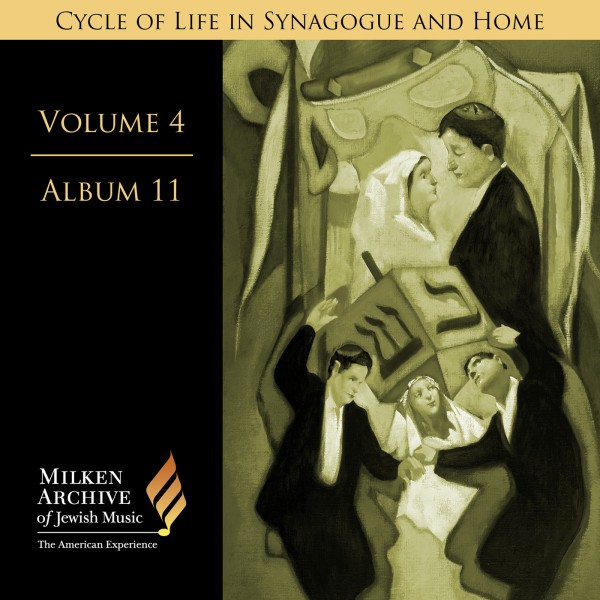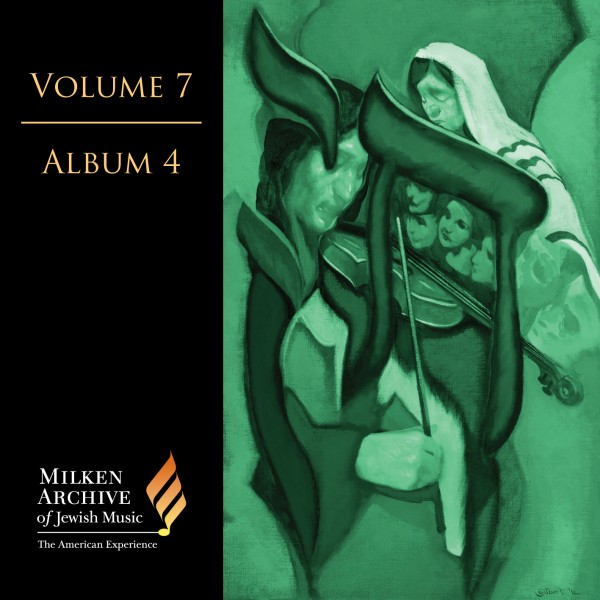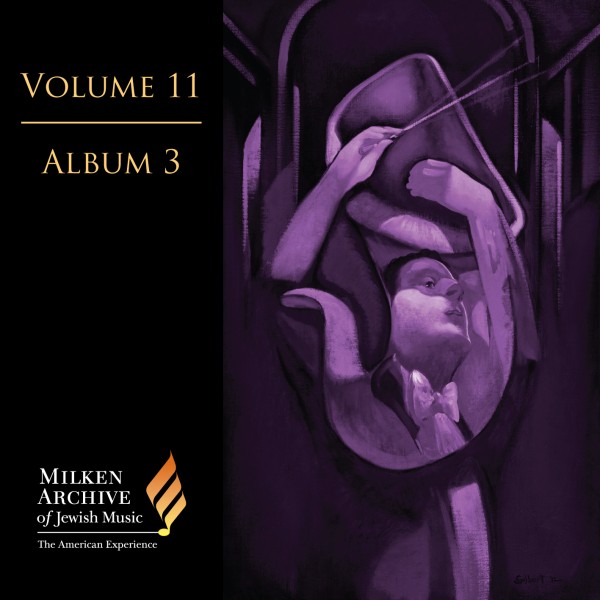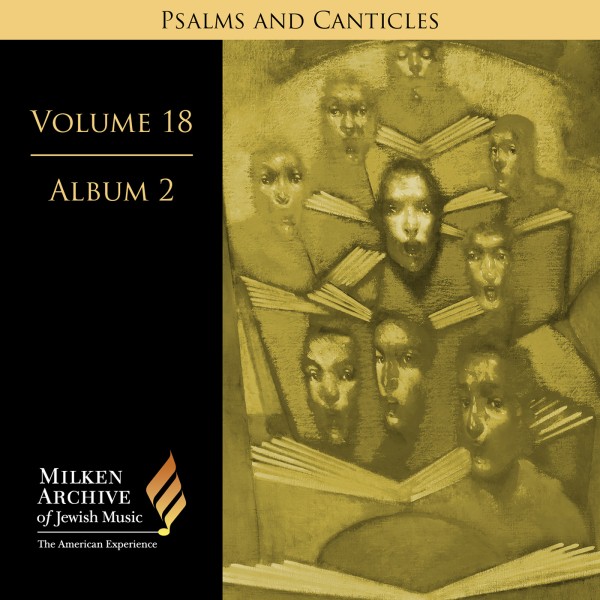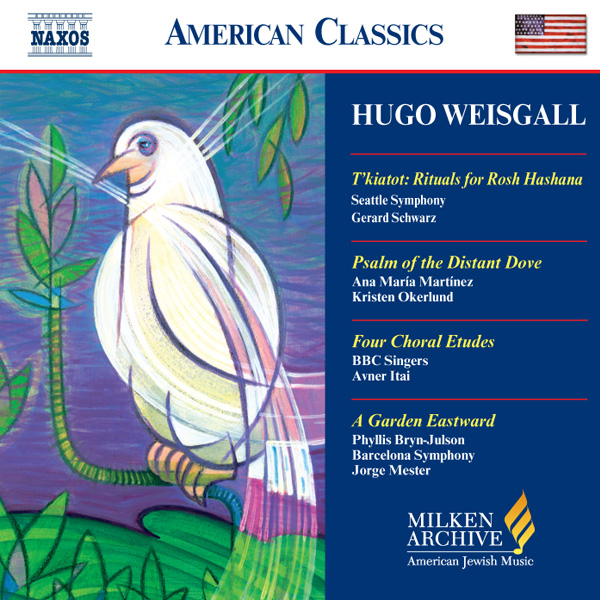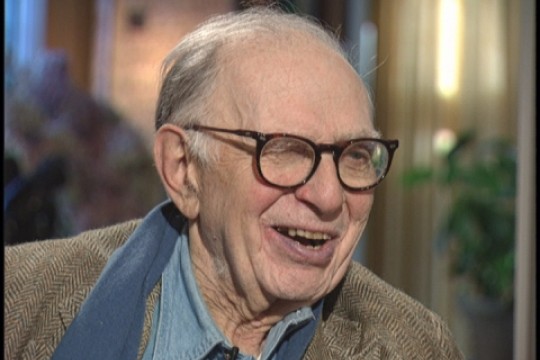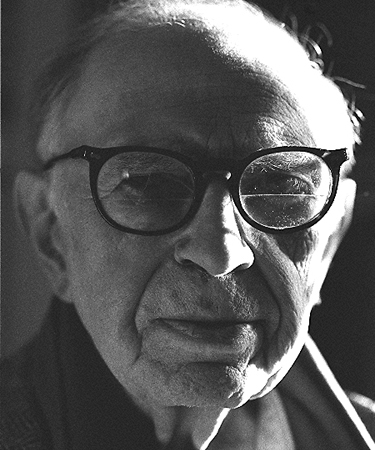
Although he wrote a substantial body of music for a number of media, Hugo Weisgall is probably best remembered as one of America’s most important composers of opera and large-scale song cycles, reflecting his intense lifelong interest in both western and Judaic literature. “I am attracted by the verbal, I am sucked aside by words,” he once said, “and I want to deal ideologically and musically with difficult problems.” The literary merit of his compositions, their original vocal style, and their serious attention to musical and dramatic detail all mark a significant contribution to American music.
The scion of a highly cultured family that boasts several generations of cantors in the Bohemian-Austrian orbit (and the nephew of the illustrious Zionist leader and producer Meyer Weisgal), Weisgall lent his artistic gifts on many occasions to the expression of historical, literary, biblical, and liturgical Jewish themes and subjects. In a class by himself, he belongs among the highest ranks of the American musical establishment, but he also championed the perpetuation of authentic Jewish musical tradition and of the Central European cantorial legacy. Among serious American Jewish composers, his singularity extended even further to the practical realm. Not only was Weisgall fully conversant with the full range of American and European synagogue choral repertoire, which Weisgall taught to cantorial students for more than forty years, but Weisgall knew the intricacies of the modal formulaic system of Ashkenazi liturgical rendition known as nusaḥ hat’filla, and Weisgall functioned as an authoritative ba’al t’filla well into his retirement.
Weisgall was born in Eibenschitz (Ivancice), a town in Moravia, then part of the Austro-Hungarian Empire (now the Czech Republic), where he claimed to have begun singing in a synagogue choir at the age of three or four. His father, Abba Yosef [Adolph Joseph] Weisgall (who added the second l to his name in America, though his brother Meyer did not), was both a cantor at the local synagogue and a classical lieder and light operatic singer. From childhood, Hugo Weisgall absorbed the Central European liturgical traditions and the western lieder and operatic canons from his father, whom he also accompanied on the piano. The family immigrated to America in 1920 and soon afterward settled in Baltimore, where Abba Yosef served for more than four decades at one of the city’s oldest and most prestigious synagogues—Chizuk Amuno Congregation. From his earliest years in Baltimore, Hugo Weisgall became intimately involved in the musical life of that congregation. For many years he conducted its choir; and he also organized and directed a mixed chorus, based there and known as the Chizuk Amuno Choral Society, which performed concert works as well and—with the esteemed cantor Jacob Barkin—issued one of the most artistic LP recordings of classic and contemporary cantorial-choral repertoire.
Apart from some consultations abroad (he went to Europe shortly before the Second World War hoping to study with Bartók, who was unwilling to take on further students), Weisgall received all of his formal education in America. He studied at the Peabody Conservatory in Baltimore, and then intermittently with Roger Sessions. At the Curtis Institute he studied with Fritz Reiner and Rosario Scalero and earned diplomas in conducting and composition, but his variegated interests led him to pursue a doctorate in other academic areas, and in 1940, Johns Hopkins University awarded him a Ph.D. for his dissertation on primitivism in 17th-century German poetry.
Weisgall’s operatic sensibilities and his gravitation to that medium was fueled not only by his natural love for the human singing voice but also by his inherent love of theater. That lifelong love affair dates to his youth. As a child of eleven, he once organized a “production” of a play he had stitched together himself about the “Knights of the Round Table,” pressing into service the children in the neighborhood for the various roles. (To no one’s surprise, the young Hugo played King Arthur.) Later, while pursuing his musical studies, he acted in small repertory theaters. From the time he began composing operas, he was always intensely involved in a working collaboration with his librettist.
During the Second World War, Weisgall served in the armed forces and for a time was an aide-de-camp to General George F. Patton. His fluency in languages eventually led to assignments of sensitive diplomatic responsibilities. While he was an assistant military attaché in London, and then a cultural attaché in postwar Prague, he conducted concerts by some of Europe’s leading orchestras, in which he promoted American music and featured American works. He also managed to compose in those difficult surroundings. In London his discovery of an anthology of war poetry inspired his song cycle Soldier Songs (1944–46), considered his first important work. In an air-raid shelter in Brussels after the Battle of the Bulge, he began writing The Dying Airmen, to words that had been published anonymously but which Weisgall maintained was actually a Spanish Civil War work by W. H. Auden. And upon viewing the hospital conditions at Terezin, the former German-built ghetto and concentration camp in Czechoslovakia, he commenced music for the Wilfred Owen poem “Futility,” about the earth’s ability to regenerate itself but the impossibility of regenerating a lost human life.
Behind the scenes during the immediate postwar years, Weisgall quietly used his military-diplomatic position to help many refugees and German concentration camp survivors. Without the required approval of his superior officer (who later congratulated him secretly), and at the risk of serious reprimand or worse, he took it upon himself to order a delay in the sealing of certain Czech border areas so that as many people as possible would not be permanently trapped behind the communist lines once the iron curtain descended.
After the war, Weisgall declined several offers for permanent conducting posts in Europe. Following his return to the United States, he founded and directed the Chamber Society of Baltimore and the Hilltop Opera Company; directed the Baltimore Institute of Musical Arts; and taught at Johns Hopkins University from 1951 until 1957—all the while continuing his work with synagogue choirs. But dearest to his heart was his forty-four-year involvement with the Jewish Theological Seminary. He established and stewarded the foremost curriculum in America for education and training in cantorial art. From its opening in 1952 until his own retirement in 1996, Weisgall was chairman of the faculty at the Seminary’s Cantors Institute and Seminary College of Jewish Music (now the H. L. Miller Cantorial School). In that capacity he functioned as a de facto codirector of the school—especially vis-à-vis its musical (as opposed to Judaica) parameters. He devoted a major portion of his energies to that role, bringing both his broad worldview of Jewish music and his exacting western musical standards to bear upon the Seminary’s approach to cantorial studies. He also taught graduate level composition and was the doctoral dissertation advisor for such important American composers as Herman Berlinski and Miriam Gideon. His legacy at the Seminary is permanently etched.
In 1961, he simultaneously became a professor of music at Queens College in New York, retiring in 1983 as Distinguished Professor. And he taught for thirteen years at The Juilliard School.
Apart from the music featured in the Milken Archive, many of Weisgall’s other works were inspired by his strong sense of Jewish identity. His fifth mature opera, Athaliah (1964), on a libretto adapted from Racine’s biblical tragedy, includes texts drawn from the Book of Psalms, and a synagogue chant is used as a cantus firmus toward the end. His next opera, Nine Rivers from Jordan (1968), deals with issues pertaining to the Holocaust, collective guilt, the collapse of the European order, Zionism and the State of Israel, and theological conceptions. That score, which drew upon the whole range of Weisgall’s personal, musical, and religious experience, incorporates such divergent elements as a well-known Passover melody and his own mock-German song.
In The Golden Peacock (1980), a setting of seven mostly familiar Yiddish folksongs, Weisgall used the original melodies as starting points to flesh out a sophisticated art song cycle that presents a genuine Yiddish folk melos within a 20th-century frame of reference. The chromatic piano parts with inventive sonorities are derived from motivic details of the tunes; and the vocal lines are treated ingeniously in order to retain their basic substance, with subtle alterations and extended material in the context of contemporary musical vocabulary and expressionist dissonance. The work, which was recorded by soprano Judith Raskin, has been called a Jewish counterpart to Bartók’s Hungarian songs and Benjamin Britten’s English songs.
In an open-ended series of perhaps a dozen short chamber pieces that he called Graven Images, Weisgall used fragments of music he had written for the 1966 CBS documentary Of Heaven and Earth, which dealt with ancient artwork by Jewish artisans. Among the individual pieces are jaunty “Holiday Dances” that refer to Jewish festivals and are scored for a number of instrumental combinations. And one is a charming, Stravinskian setting of Psalm 29, in Hebrew, for solo voice (or chorus) and piano.
Although he occasionally wrote liturgical settings when he first directed synagogue choirs in Baltimore, it was not until the 1980s that Weisgall was commissioned to write a complete formal synagogue service. That work, Evening Liturgies, is a Reform Friday evening (Sabbath eve) service according to the Union Prayer Book, scored for baritone cantor, mixed chorus, and organ. Prior to the premiere of the entire work, two orchestrated movements, under the title Sacred Fragments, were performed at an international conference in New York. Bernard Holland, in his review in The New York Times, observed: “Here, the love of soaring stentorian singing and sweeping string sound served to soften Weisgall’s acid, penetrating harmonies.” Another of his important Judaically related works is Love’s Wounded, a setting of poetry by Yehuda Halevi (ca. 1075–1141) for baritone and orchestra, premiered by the Baltimore Symphony conducted by David Zinman.
No proper consideration of Weisgall can ignore some of his operas outside the Judaic realm—especially Six Characters in Search of an Author (1956), based on the Pirandello play. Probably more than any other, that work first catapulted him to international attention in the opera world. Among his other important operas are The Tenor (1950), based on Frank Wedekind’s expressionist one-act play, Der Kammersänger; The Stronger (1952), written expressly for his Hilltop Opera Company and based on Strindberg’s psychological monodrama; and Purgatory (1958) to William Butler Yeats’s allegorical verse play, in which Weisgall adapted twelve-tone techniques for the first time. His instrumental works include orchestral pieces, a piano sonata, incidental music, chamber music, and several ballets.
Weisgall was an intellectual of broad, high-minded interests. He published articles on American Impressionist painting and on contemporary music and composers, and he lectured widely on Jewish and general musical topics. He was president of the American Music Center (1963–73) and of the League of Composers/ISCM, and he was a composer-in-residence at the American Academy in Rome in 1966. Among his numerous prizes, awards, and honors were three Guggenheim fellowships, the Lifetime Achievement Award from Opera America (1994), the Gold Medal for music from the American Academy of Arts and Letters (1994), the William Schuman prize from Columbia University, the first award in the arts from the National Foundation for Jewish Culture (now the Foundation for Jewish Culture), and several honorary doctorates. He was elected to the American Academy of Arts and Letters in 1975, and he served as its president from 1990 until 1993. He also directed the inaugural term of the composer-in-residence program of Lyric Opera of Chicago (1988–97).
Projects on Weisgall’s desk at the time of his 1997 death included the beginnings of a second set of settings of Yiddish folk melodies; operatic versions of two plays by Jean Anouilh, several scenes of which were sketched out to libretti by Charles Kondek, the librettist for Esther; and a new opera based on John Hersey’s novel The Wall, about the Warsaw Ghetto uprising (according to Kondek, they had almost finished a draft of the complete libretto), which was to have been produced by New York City Opera. He was also sketching out a group of liturgical settings for the typical format in Conservative synagogues.
Weisgall’s earlier style has been appraised as a fusion of nontonal neoclassicism with certain influences of the Second Viennese School of composers, such as Alban Berg, colored by the general opulence of that period. But his later music more closely approaches that Second Viennese School, especially its most lyrical aspects. Even at its most rigorous-sounding moments, however, it is generally more a matter of strident, even severe, chromaticism than actual atonality—although Weisgall himself was never comfortable with such classifications.
In 1958, the eminent American composer George Rochberg described Weisgall’s music as leaning “towards free tonality; he is never quite atonal.” But nearly twenty years later Weisgall assessed his own approach from another perspective: “Generally my music is considered complex,” he said. “It is texturally thick and multifarious; rhythmically disparate; and [it] has harmonic lines that move along on their own. It is what is commonly called atonal, but it is not nonmelodic.”
Rochberg also astutely summarized Weisgall’s basic artistic credo at that time: “Among American composers he is one of the few who remain heedless of the musical clichés which superficialize and debilitate American music. There is strength and hope in such an independent attitude.” Weisgall remained steadfast to those principles for nearly forty years more. He never succumbed to popular tastes or the lure of wider acceptance; and he never strayed from his own artistic integrity.
By: Neil W. Levin and Bruce Saylor
